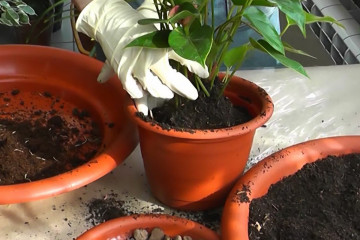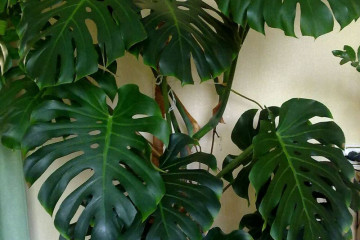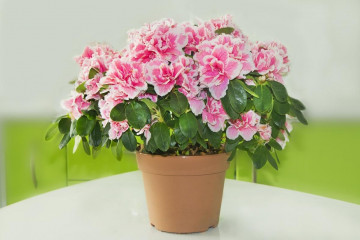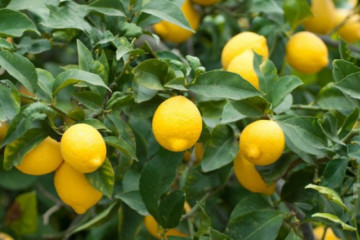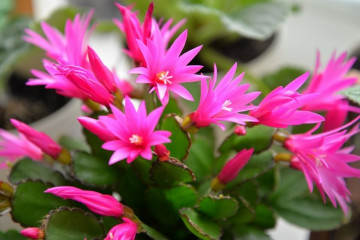Guzmania: plant transplant and home care
Content:
The choice of decorative flowers for the home is huge. But more and more experienced gardeners and amateurs began to pay attention to exotic plants. One of these is guzmania. This culture is known for its unusual appearance, ease of care. If there is a desire to acquire this miracle of nature, it is better to immediately study all the features of its cultivation.
Botanical description
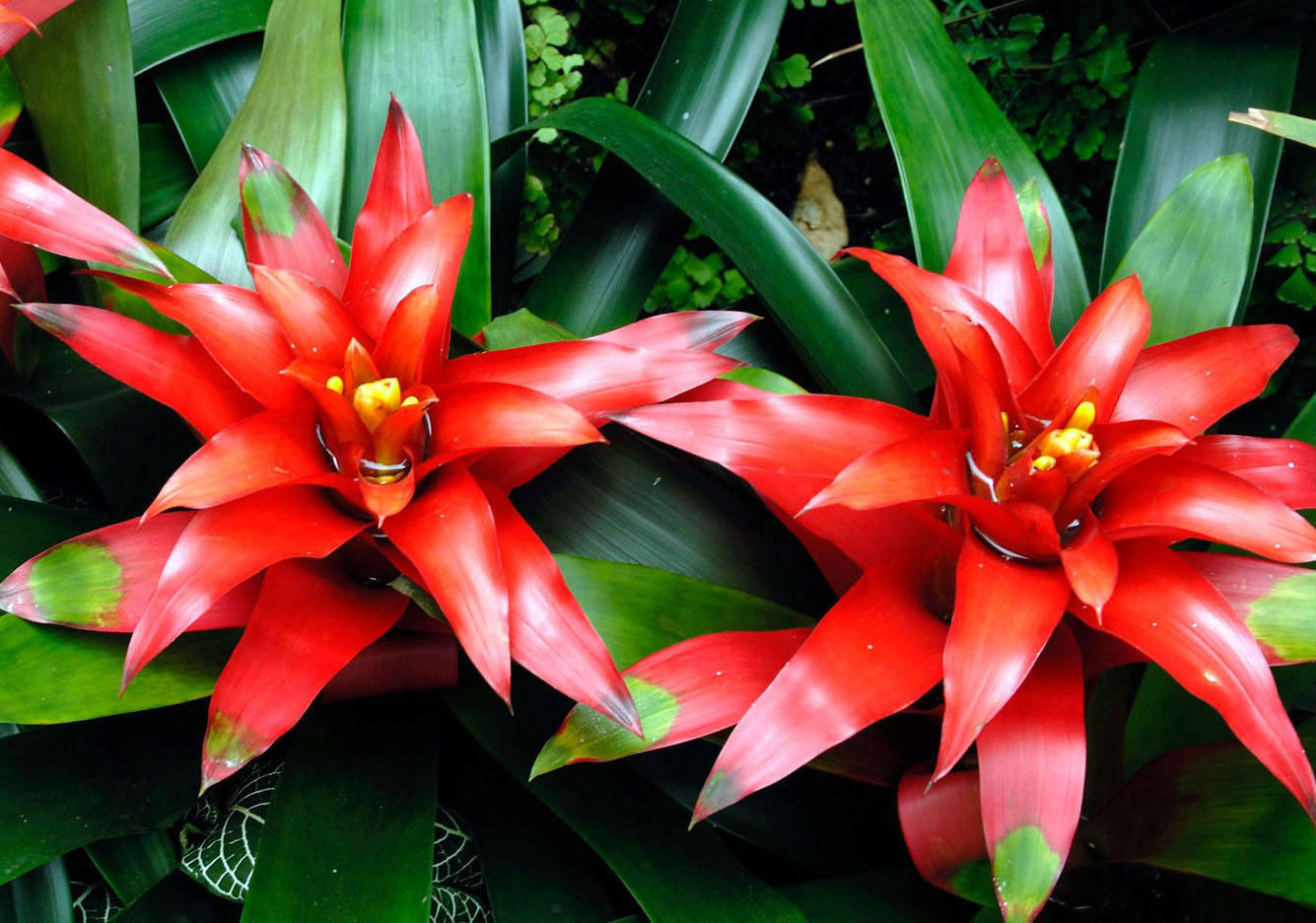
Guzmania - a tropical culture with unusual flowering
The flower with red leaves on the crown was named "Guzmania" in honor of the Spaniard A. Guzman, a zoologist, pharmacist and botanist, who first mentioned a new species of the Bromeliad family back in 1802.
Like many members of this family, the guzmania has leaf plates that overlap one another in the shape of a bowl. The length of the leaves is up to 70 cm, and the rosette that they form can reach a height of 50 cm. The plant blooms in spring or autumn for several months. The flower is inconspicuous, but its bracts stand out for their decorative effect. They can be colored orange, red, white or yellow. The inflorescence, as if varnished, looks unusual and impressive. An adult bush in the wild grows up to 80 cm.Home specimens are rarely taller than 40 cm.
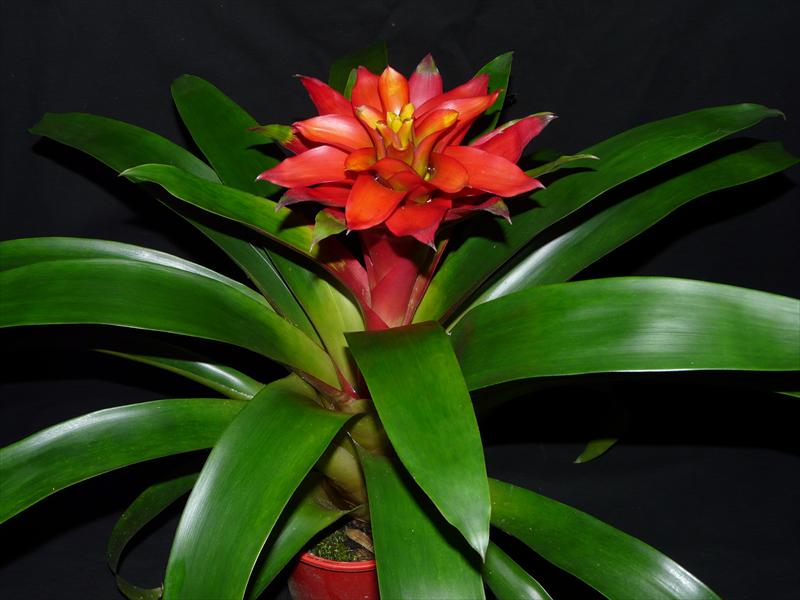
The flower with red leaves on the crown is named after the biologist A. Gusman
The main types of guzmania
In the world, thanks to the science of breeding, almost 200 species of guzmania have been bred. Their difference is in the color of the bract, flower or leaf plate. Some of them live in the ground, others on old snags, even on the slopes of rocks. In home cultivation, the following types predominate:
- Tempo Extra. An evergreen crop most commonly sold in flower shops. The foliage is bright green with a golden tint. The bract is red. It blooms for a long time, is not capricious in leaving.
- Ostara. A plant with smooth narrow leaves in a lush rosette. Blooms from late winter to early autumn. After flowering, it dies, but several daughter bushes remain in the place of the mother plant, which, after transplantation, are capable of independent life.
- Lingual guzmania. One of the most popular varieties. The bright bracts of short stipules can be purple, orange, red, or white. The leaf is rich green, sweeping, collected in a strong rosette.
- Minor Rondo. A small bush with narrow, short green or variegated leaves. The bract is red or orange in color. After dying off, leaves daughter sprouts.
- Hilda. Large plant, can grow up to 70 cm. Leaves are light, slightly pointed at the ends. The bract is low, the rosette is loose. The top is highlighted with a bright lemon color. Blooms for at least 4 months.
- Mosaic. An annual culture with a beautiful, lush, spreading rosette of long leaves. The pointed stipules have a bright pink ellipse fort. Flowers in stipules are light yellow.
The name means several varieties in one container. They are placed so as to get a bright and varied flowering from bushes of several colors.

Guzmania mix is several varieties of different colors in one container
Plant care at home
Hybrids and varieties of crops that are grown at home do not differ in care. Guided by advice on cultivation and observing the rules of agricultural technology, you can increase the flowering time of guzmania and avoid its wilting.
Temperature
A tropical guest easily adjusts to the temperatures of city apartments. But he really does not like their sudden fluctuations and drafts. Summer indicators should not drop 22 degrees Celsius, winter - 17.
Lighting
Guzmania feels good in light partial shade. Under bright sunlight, the decorativeness of the bracts is lost, they fade. It is better for representatives of the Bromeliads to live on the east or west windows. If bromeliads are placed on the north side, there is a risk of not waiting for them to bloom.
Priming
When a flower appears, the question arises which soil is suitable for guzmania. The soil for guzmania should conduct moisture and air well. In horticultural stores, ready-made soil for bromeliads is sold. A mixture for phalaenopsis is also suitable. You can prepare the correct soil for guzmania with your own hands based on moss, sand, peat and leafy soil mixture.
Fertilizers
Fertilize the tropicana with the arrival of spring and until the end of summer once a month with special dressings for bromeliads. The solution is prepared in half weaker than indicated in the instructions. Pour it directly into an outlet or spray it on the plant.
Watering
Watering guzmania is different from usual. Water is poured into the outlet, and not at the root, as is customary with most plants. The flower rosette should be slightly more than half full. Water is used purified or long-standing, at room temperature. During the warmer months, there should always be moisture in the outlet. But once a month it is freed from moisture, dries up, and the water must be replaced.
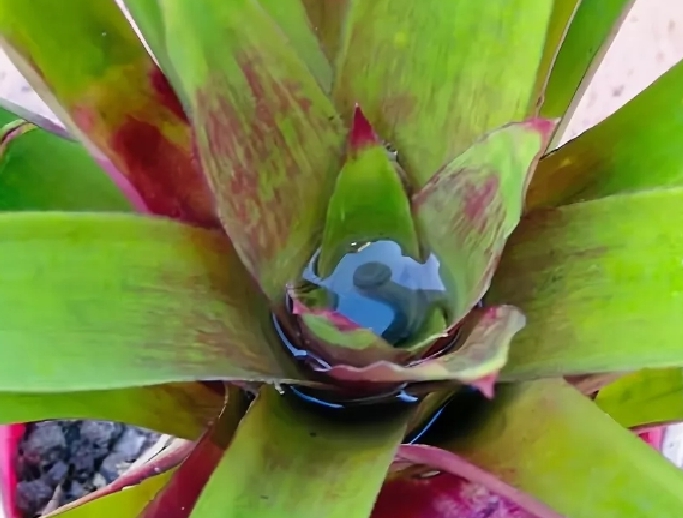
Watering guzmania is carried out directly into the outlet
Transfer
A transplant is required for a guzmania flower in several cases:
- when the capacity has become small;
- when separating children;
- Guzmania transplant after purchase;
Step-by-step instructions on how to transplant guzmania at home after purchase:
- A shallow flowerpot is taken, 5-7 cm more than the shipping one.
- The soil is being prepared, which should include peat, leafy earth, sand and humus in equal parts.
- A third of the flowerpot is filled with drainage from pebbles, expanded clay or foam.
- The plant is rolled with an earthen clod into a new container and sprinkled with soil, without tamping.
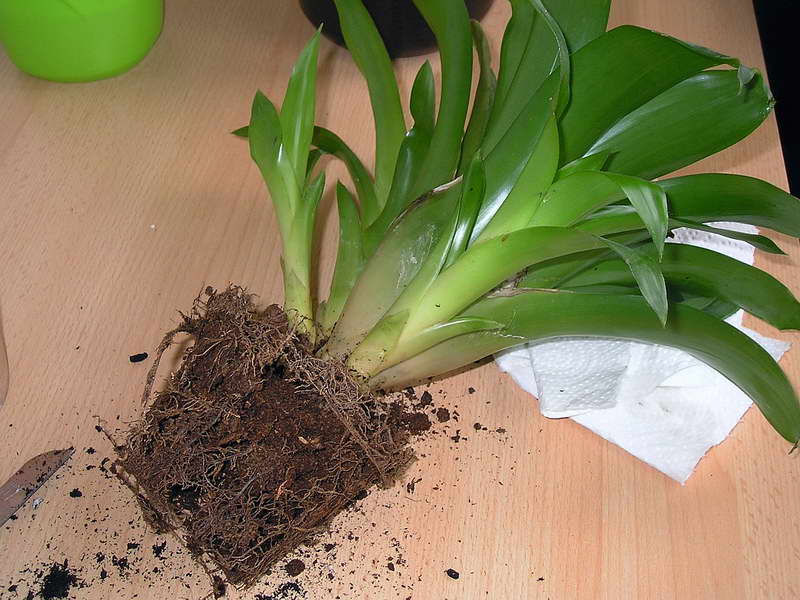
The plant is transplanted by the transshipment method together with an earthen clod
Bloom
This is a very important step. A culture has flowering only once: the first and the last.
No matter how long the guzmania bloomed, but with the beginning of autumn, the flower dries up. At this time, watering and feeding are reduced. The peduncle is cut along with the dried foliage. Watering is carried out through the pallet.
Often on the forums of gardeners there is a question why the guzmania does not bloom. The problem is solved by proper lighting, regular watering and fertilization.
Reproduction
The owner of such beauty will be interested to know how guzmania multiplies and how painstaking it is. It is not very difficult to reproduce it, but there are some points that you need to know about and then there will be no problems.
Seed propagation
For propagation by seeds, prepare a container with a soil substrate for orchids or bromiliums.Seed material is washed with manganese solution, dried and laid out on the ground. The seeds are not buried, but placed on the ground. The container is covered with glass or foil, creating a greenhouse effect. In this case, do not forget about regular ventilation.
Germinate seeds in a warm and well-lit place where the air temperature does not drop below 22 degrees. From time to time, the soil is moistened by spraying. The first shoots should appear in 2 weeks. A pick is carried out when the seedlings are 2 months old, seating them in separate cups. 2 weeks after picking, young plants are transplanted into pots. Such a bush will bloom in 4 years.
Reproduction by children
After the culture has managed to bloom and before it withers, it is time for reproduction by daughter processes. The faded mother bush forms lateral processes that form its own root system. It will be possible to plant the children separately when their roots grow to two centimeters.
How to plant the children of Guzmania:
- daughter processes are cut from the mother bush with a sharp, sterile knife or blade;
- the places of the cuts are processed with garden pitch or crushed coal;
- children are put in a separate container, placed in a warm place under a film or covered with a plastic bottle;
- when young plants get stronger, they are transferred together with an earthen clod into a pot with a special substrate;

The mother bush forms daughter shoots, children, which, after transplantation, retain all the ornamental qualities of the plant
Possible growing problems
Sometimes there are some difficulties in growing plants. There are also problems in caring for an exotic beauty:
- Leaves dry. This happens due to a lack of moisture or excess moisture in the outlet. Regulated watering will help to solve the problem.
- Aphids or scale insects on the leaves. Diseased leaves must be removed. Shed the culture and spray with fungicides.
- The drooping, soft leaves are the flower's response to low air temperatures.
- There are no daughter processes. This happens due to the low content of nutrients in the soil.
Subject to all the tips and rules of agricultural technology, guzmania will delight you with its flowering for more than one month. Will grow without whims and problems. Will give a sense of harmony to its owner.
